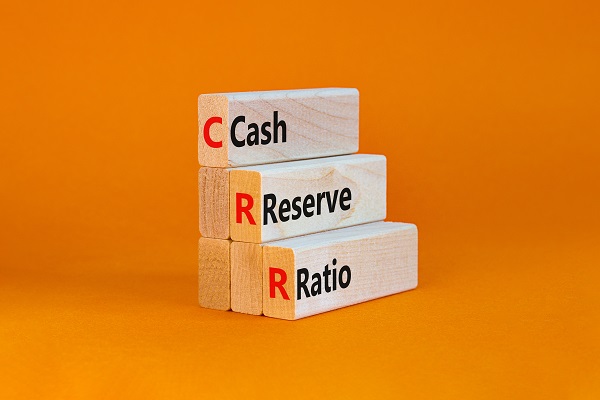Cash Reserve Ratio (CRR) – Current Rate and Impact on Economy

What is Cash Reserve Ratio (CRR)?
Cash Reserve Ratio (CRR) is the minimum percentage of its total deposits that it must maintain as cash or cash equivalents with the Reserve Bank of India (RBI). The cash can either be held by the bank in its own vaults or parked with the RBI, on which it earns no interest. The bank cannot use this reserve to expand credit or to pay off debts.
The RBI uses it as one of the many monetary policy tools at its disposal to manage liquidity pressures and money supply. The RBI periodically reviews and determines the CRR rate. The CRR regulation is applicable only for scheduled commercial banks, but does not apply to non-banking financial companies (NBFCs) and regional rural banks (RRBs).
What is the Current Cash Reserve Ratio Rate in India?
The current CRR rate is 4.5%. This means that every scheduled commercial bank is required to maintain 4.5% of its net demand and time liabilities (i.e. deposits) with the Reserve Bank of India as cash or cash equivalents. The CRR rate is calculated for a bank on a fortnightly basis, which means that a bank’s compliance with the CRR limit is evaluated after every 14 days.
Did You Know?
The CRR rate was last changed on 4th May, 2022. The CRR rate was increased by 50 basis points from 4% to 4.5%. It has remained unchanged ever since.
How Does Cash Reserve Ratio Work?
CRR is an important monetary policy tool that is used by the RBI to control liquidity. When RBI increases the CRR, banks have less funds to lend. This increases the cost of borrowing as a result of which less money goes into circulation. This can help contain inflation, but may also reduce the pace of economic growth. On the other hand, when CRR is reduced, banks have more funds to lend. This injects more liquidity into the market, thereby increasing the pace of growth.
Currently, the cash balance to be maintained by a bank with RBI needs to be 4.5% of its Net Demand and Time Liabilities (NDTL). This means that for every ₹100 deposited with a bank, ₹4.5 must be parked as cash either in the bank’s vault or with the Reserve Bank of India (RBI).
Also Read
Objectives of Cash Reserve Ratio
The primary objective of cash reserve ratio is to ensure that commercial banks have sufficient liquidity to meet the cash withdrawal demands of their depositors and other obligations.
Here are some of the other objectives of Cash Reserve Ratio (CRR):
- It ensures that a fraction of the bank’s deposits are secured with the RBI to maintain solvency.
- It regulates the cash flow in the economy. The policies decided by the RBI determine how much money will stay in circulation.
- CRR helps keep inflation within limits. For instance, when inflation gets high, RBI increases the CRR to reduce the ability of banks to sanction loans. This results in the reduction of market liquidity, which helps bring down inflation.
- CRR helps during liquidity crunches in the market. During these periods, RBI reduces the CRR so that banks can lend more money to people to stimulate economic growth and revival.
How Does CRR Control Inflation?
RBI uses CRR as a monetary policy tool to control inflation. By increasing CRR, RBI can force banks to park more money with it, which in turn reduces their ability to lend money to borrowers. This increases the cost of borrowing, reduces the supply of money into the markets, and thereby helps bring down inflation.
Why Does the Cash Reserve Ratio Keep on Changing?
The RBI changes CRR from time to time to control inflation and liquidity risks. RBI can change it not only to stay in line with its monetary policy and fiscal goals, but also to ensure that depositors have a safety net, in case there is a sudden surge in demand for funds through withdrawals. It also helps keep banks solvent and prevents a build up of non-performing assets.
Penalties for Non-Maintenance of Cash Reserve Ratio
In the event of failure to comply with RBI’s Cash Reserve Ratio norms, a bank will be penalised as follows:
- If a bank fails to maintain a minimum of 90% of the required Cash Reserve Ratio on all days over a period of 14 days, such that the average CRR during the period falls below the prescribed limit, the following penalty charges will apply:
- The penalty is only imposed on the amount by which the bank failed to meet the minimum CRR norm for the day
- On the first day of failing to meet the minimum CRR limit, the bank will be charged 3% p.a. on top of the bank rate i.e. the interest rate charged by the RBI for lending funds to a commercial bank
- On every subsequent day of failure to meet the RBI’s minimum CRR limit (during that particular fortnight), a fine of 5% p.a. will be applied over and above the bank rate for the day
Example:
Let us understand it better with an example. If the CRR norm for a bank for a particular day was ₹500 Crore and it managed to maintain ₹450 Crore for the day, then the penalty will be applied only on ₹50 Crore (500-450) and not on ₹450 Crore. For the first day, a penalty of 3% p.a. will be applied. But, on every subsequent day, the fine will be increased to 5% p.a. + the bank rate.
Cash Reserve Ratio Formula and Calculation
The calculation for CRR depends on a bank’s net demand and time liabilities (NDTL). In simple words, NDTL can be defined as the total deposits of a bank kept with the public and other banks minus other banks’ deposits. Liabilities that constitute NDTL include current deposits, fixed deposits, gold deposits, cash certificates, demand drafts, and dividends among others.
Formula for Calculating CRR
There is no specific mathematical formula for calculating CRR. It is simply the percentage of a bank’s NDTL that it must hold as cash reserves. Currently, it is 4.5%.
So, Cash Reserve Ratio (CRR) = Percentage of a bank’s total deposits i.e. NDTL held as cash or cash equivalents
How to Calculate CRR?
Calculating CRR is quite simple. Let’s understand it with an example.
Let’s assume that a bank has ₹500 crore in total deposits. Let us also assume that the CRR is 4.5%.
The minimum Cash Reserve Ratio that the bank must meet is 4.5% of ₹500 Crore = 4.5/100×500 Crore= ₹22.5 Crore
So, the bank will have to hold ₹22.5 Crore as cash in its vault or parked with the RBI. This amount cannot be used by the bank for investment and lending.
What Happens if CRR Increases?
When the RBI increases the cash reserve ratio (CRR), commercial banks are forced to hold a larger percentage of their total deposits as cash with the central bank. As a result, banks have less money available to lend or invest, which can lead to a decrease in the supply of credit in the economy. This can slow down the economy, as it becomes more difficult for individuals and businesses to access credit. But, sometimes the RBI needs to use this strategy to control inflation and oversupply of money.
Effect of Cash Reserve Ratio on Economy
1. Effect on Inflation
CRR is one of the most powerful monetary policy instruments available to the RBI to control inflation and overcirculation of cash.
The Reserve Bank of India enhances the CRR levels that help reduce the amount of money that commercial banks have to lend. In turn, it lessens the money supply in the economy. Although it can temporarily slow down the country’ economy, it is an effective ploy to control inflation.
2. Effect on Interest Rate
When the cash reserve ratio increases, banks reduce the expansion of credit. As a result, this will make people keep more deposits in their bank accounts. It forces banks to increase the rate of interest, thereby discouraging borrowers from applying for credit.
So, with higher interest rates, loan expenses increase, thereby drying up the availability of funds for borrowing.
Difference between Cash Reserve Ratio (CRR) and Statutory Liquidity Ratio (SLR)
The major differences between Cash Reserve Ratio and Statutory Liquidity ratio are as follows:
| Prospect | CRR | SLR |
| Meaning | CRR is a certain portion of the total deposits that the commercial banks keep as a reserve with the central bank. | SLR refers to the portion of their deposits that banks are supposed to hold as liquid assets, including cash, sovereign bonds, gold, and other government-approved securities |
| Form | Cash and cash equivalents | Liquid Assets |
| Use | To control liquidity | To control credit expansion |
| Held with | Central Bank or RBI (Reserve Bank of India) | Bank itself |
| Returns | Banks earn no interest on their CRR reserves | Banks may earn interest from their SLR reserves |
Final Word
CRR or Cash Reserve Ratio is the minimum stipulated percentage of deposits that commercial banks must hold with the Reserve Bank of India as cash or cash equivalents. Central Banks use CRR to control the interest rates for lending and for controlling money supply in the markets.
Since we are talking about money, how about we introduce you to a security that could help you maximise the profit margins on your investments? Yes, we are talking about Navi Mutual Fund schemes, which are passively managed, technology-backed, low-cost, and extremely transparent. Being index-linked, you have the potential to maximise returns in line with the performance of the underlying indices. What’s even better? You could start your investment journey with just ₹10. To start, download the Navi App today and try for yourself!
FAQs
Cash Reserve Ratio (CRR) and Statutory Liquidity Ratio (SLR) are both important concepts in banking. While CRR is the reserve that banks maintain with the RBI, SLR is the reserve that the banks must maintain themselves before offering credit. Moreover, banks must maintain SLR in the form of cash, gold and other securities, unlike CRR, which must be held as cash.
The current cash reserve ratio set by the RBI is 4.50%. The RBI keeps on changing this value based on various factors.
The CRR is set and maintained by the Reserve Bank of India. They keep on changing the CRR on a fortnightly basis.
The Cash Reserve Requirement is calculated as the CRRs percentage of the NDTL. For instance, let us assume that the CRR is at 4% and the NDTL of a bank is Rs. 200 crore.
The Cash Reserve Requirement for the bank would be: Rs. [(4 / 100) x 200 crore)] = Rs. 8 crore
When RBI increases the CRRR, banks are left with fewer funds to sanction loans and make investments. The reduced cash flow helps in bringing down inflation.
There is no upper or lower limit on CRR. Till 2006, the lower and upper CRR limits were 3% and 20% respectively. However, it was abolished and ever since there has been no upper cap.The CRR rate is 4.5%.
There is no minimum limit. It used to be 3% until 2006 when the government decided to do away with the lower limit.
The full form of CRR is Cash Reserve Ratio
Yes, CRR must be maintained by all banks. However, regional rural banks and NBFCs have an exemption.
The Reserve Bank of India has the sole authority to determine and control CRR and SLR.
Personal Loan in Your City

Customer’s Feedback
No comments found.10 Best Bank for Savings Account in India [Highest Interest Rate 2023]
Savings account is a type of financial instrument offered by several banks. It lets you safely depo... Read More »What is Issuer Identification Number (IIN)- Working and Importance
What is an Issuer Identification Number (IIN)? Banks and financial institutions assign a distinc... Read More »What is a Vostro Account – Meaning, Working and Difference
What is a Vostro Account? A Vostro account is a bank account held by a domestic bank on behalf o... Read More »What is a Solvency Certificate? – Format, Documents Required & How to Apply Online?
What is a Solvency Certificate? A solvency certificate is a legal document furnishing the detail... Read More »What is Merchant Banking – Services, Features, Functions and Example
What is Merchant Banking? Merchant banking is a set of select banking and financial services off... Read More »Automated Clearing House: Objectives, Types and Process
Automated Clearing House is an electronic fund transfer network that manages automatic and direct... Read More »How to Redeem Credit Card Reward Points ?
Credit Card Reward points are types of incentives that customers receive when they use a credit car... Read More »What is Electronic Clearing Service (ECS) in Banking and How does it Work?
What is Electronic Clearing Service (ECS)? Electronic Clearing Service (ECS) is a method of elec... Read More »What are Credit Card Validators and How to Use them?
What is a Credit Card Validator? A credit card validator is a tool that checks the validity of a... Read More »What is Cash Management and How Does it Work?
Managing available capital can make sure that a small business stays afloat. Cash management is an ... Read More »What are Prepaid Expenses? – Definition, Examples, and Journal Entry
Prepaid expenses represent payments made in advance for products or services expected to be incurre... Read More »Increase Credit Card Limit – Important Tips and How to Do It?
The credit card limit is the maximum amount of money you can spend using your credit card. Your cre... Read More »Top 10 Chit Fund Schemes in India in 2023
Chit funds are one of the most popular return-generating saving schemes in India. It is a financial... Read More »10 Best Gold ETFs in India to Invest in April 2023
Gold ETFs or Gold Exchange Traded Funds are passively managed funds that track the price of physica... Read More »10 Best Demat Accounts in India for Beginners in 2023
Creation of Demat accounts revolutionised the way trades were conducted at the stock exchanges. It... Read More »20 Best Index Funds to Invest in India in April 2023
What is an Index Fund? An index fund is a type of mutual fund or exchange-traded fund (ETF) that... Read More »Best Arbitrage Mutual Funds to Invest in India in April 2023
Arbitrage funds are hybrid mutual fund schemes that aim to make low-risk profits by buying and sell... Read More »10 Best SIP Plans in India to Invest in April 2023
What is SIP? SIP or Systematic Investment Plan is a method of investing a fixed amount in ... Read More »10 Best Corporate Bond Funds in India to Invest in April 2023
Corporate bond funds are debt funds that invest at least 80% of the investment corpus in companies ... Read More »10 Best Bank for Savings Account in India [Highest Interest Rate 2023]
Savings account is a type of financial instrument offered by several banks. It lets you safely depo... Read More »





















